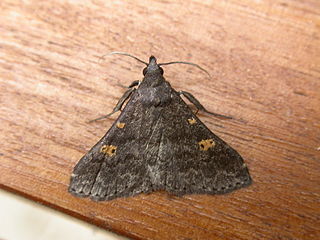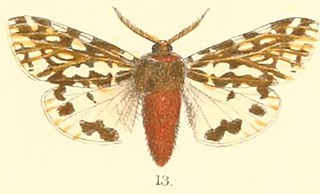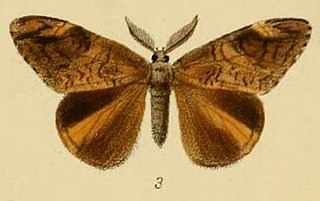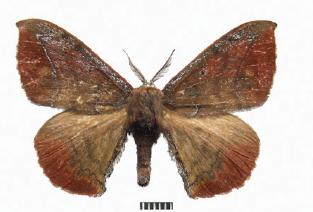
The red panda, also known as the lesser panda, is a small mammal native to the eastern Himalayas and southwestern China. It has dense reddish-brown fur with a black belly and legs, white-lined ears, a mostly white muzzle and a ringed tail. Its head-to-body length is 51–63.5 cm (20.1–25.0 in) with a 28–48.5 cm (11.0–19.1 in) tail, and it weighs between 3.2 and 15 kg. It is well adapted to climbing due to its flexible joints and curved semi-retractile claws.

Bombyx mori, commonly known as the domestic silk moth, is a moth species belonging to the family Bombycidae. It is the closest relative of Bombyx mandarina, the wild silk moth. Silkworms are the larvae of silk moths. The silkworm is of particular economic value, being a primary producer of silk. The silkworm's preferred food are the leaves of white mulberry, though they may eat other species of mulberry, and even leaves of other plants like the Osage orange. Domestic silk moths are entirely dependent on humans for reproduction, as a result of millennia of selective breeding. Wild silk moths, which are other species of Bombyx, are not as commercially viable in the production of silk.

Cyana is a genus of moths in the family Erebidae. Species are well distributed in Africa, Madagascar, China, India, Sri Lanka, Myanmar, Sumatra, Java and Borneo. The genus was erected by Francis Walker in 1854.

Ficus neriifolia is a species of fig (Ficus). It is native to Asia, including Bhutan, Burma, China, India, and Nepal.

Naarda is a large genus of erebid moths which currently encompasses 108 species. Initially identified by Francis Walker in 1866, it is in the family Erebidae. Somewhat ruddy in appearance, this genus is primarily distinguishable for its generally slender thorax and abdomen, and straight, porrect labial palpi. Most species are dark beige, but shading can reach a deep charcoal. Most species possess muddy yellow, reniform, orbicular stigmata featured on the forewings, which is reflected bilaterally superior on some species.

Miltochrista is a genus of moths of the family Erebidae, subfamily Arctiinae. The genus was erected by Jacob Hübner in 1819.

Alphaea is a genus of tiger moths in the family Erebidae. The genus was erected by Francis Walker in 1855. They are found on India, Sri Lanka, Myanmar and Java only.

Rhagoba is an oriental genus of moths of the family Crambidae described by Frederic Moore in 1888. Species of the genus resemble those of Pygospila, but can be told apart by genital differences in both sexes and by a stronger metallic blue reflection on the thorax. Species are known only from Asia, where they have been recorded from China, Vietnam, Laos, India, Nepal and Bhutan.

Aroa is a genus of moths in the subfamily Lymantriinae first described by Francis Walker in 1855. Species are distributed in South Africa, China, throughout India, Sri Lanka, Myanmar, and Java.

Asota is a genus of moths in the family Erebidae first described by Jacob Hübner in 1819. Species are widely distributed throughout Africa, India, Sri Lanka, Myanmar, the Malayan region and tropical parts of the Australian region.

Heliothinae is a small, cosmopolitan subfamily of moths in the family Noctuidae, with about 400 described species worldwide. It includes a number of economically significant agricultural pest species, such as Helicoverpa armigera and Helicoverpa zea.

Andraca is a genus of moths of the family Endromidae.

Andraca bipunctata is a moth of the family Endromidae. It is found in China (Yunnan), India, Bhutan, northern Thailand, Myanmar and Nepal. The larvae are referred to as bunch caterpillars.
Monema is a genus of moths of the family Limacodidae.

Belippa is a genus of moths in the family Limacodidae erected by Francis Walker in 1865.

Gazalina transversa is a moth of the family Notodontidae first described by Frederic Moore in 1879. It is found in Sikkim in India and in China.

Cyclidia is a genus of moths belonging to the subfamily Cyclidiinae. The genus was erected by Achille Guenée in 1857. Cyclidia is one of two genus in the subfamily Cyclidiinae, the other being Mimozethes. The two genus differ in their genitalia, the male genitalia of the cyclidia is more developed and the female genitalia contain sclerotization, where Mimozethes does not.
Seasonal hyperacute panuveitis is an aggressive eye disease of unknown etiology, first described in 1975. It has been recorded almost exclusively from Nepal, with the exception of five cases reported from Bhutan. The disease affects prevalently children and can cause blindness. In Nepal, it is the most common reported cause of panuveitis, and in children it is the most prevalent cause of both uveitis and panuveitis.















